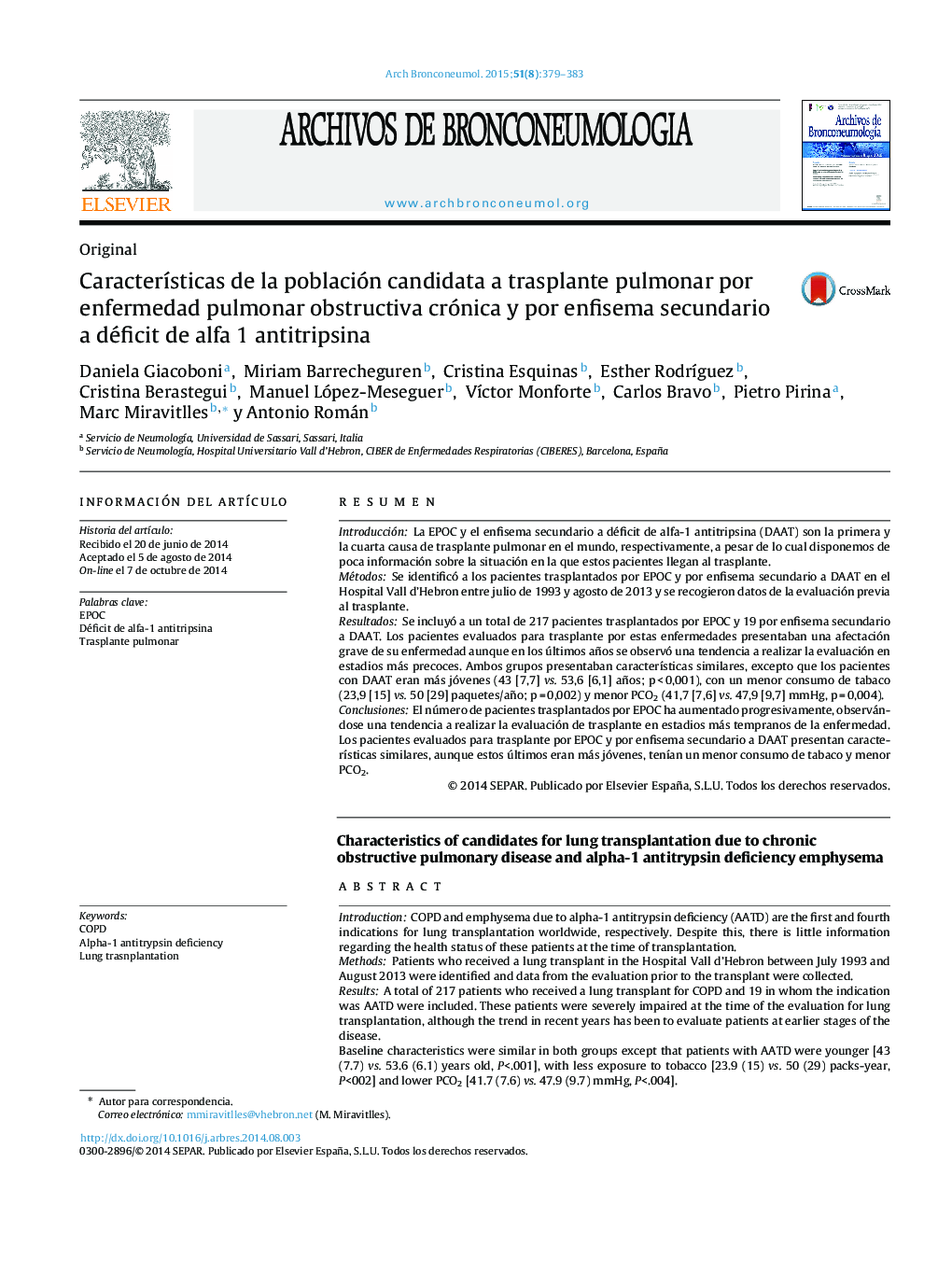| Article ID | Journal | Published Year | Pages | File Type |
|---|---|---|---|---|
| 4203182 | Archivos de Bronconeumología | 2015 | 5 Pages |
ResumenIntroducciónLa EPOC y el enfisema secundario a déficit de alfa-1 antitripsina (DAAT) son la primera y la cuarta causa de trasplante pulmonar en el mundo, respectivamente, a pesar de lo cual disponemos de poca información sobre la situación en la que estos pacientes llegan al trasplante.MétodosSe identificó a los pacientes trasplantados por EPOC y por enfisema secundario a DAAT en el Hospital Vall d’Hebron entre julio de 1993 y agosto de 2013 y se recogieron datos de la evaluación previa al trasplante.ResultadosSe incluyó a un total de 217 pacientes trasplantados por EPOC y 19 por enfisema secundario a DAAT. Los pacientes evaluados para trasplante por estas enfermedades presentaban una afectación grave de su enfermedad aunque en los últimos años se observó una tendencia a realizar la evaluación en estadios más precoces. Ambos grupos presentaban características similares, excepto que los pacientes con DAAT eran más jóvenes (43 [7,7] vs. 53,6 [6,1] años; p < 0,001), con un menor consumo de tabaco (23,9 [15] vs. 50 [29] paquetes/año; p = 0,002) y menor PCO2 (41,7 [7,6] vs. 47,9 [9,7] mmHg, p = 0,004).ConclusionesEl número de pacientes trasplantados por EPOC ha aumentado progresivamente, observándose una tendencia a realizar la evaluación de trasplante en estadios más tempranos de la enfermedad. Los pacientes evaluados para trasplante por EPOC y por enfisema secundario a DAAT presentan características similares, aunque estos últimos eran más jóvenes, tenían un menor consumo de tabaco y menor PCO2.
IntroductionCOPD and emphysema due to alpha-1 antitrypsin deficiency (AATD) are the first and fourth indications for lung transplantation worldwide, respectively. Despite this, there is little information regarding the health status of these patients at the time of transplantation.MethodsPatients who received a lung transplant in the Hospital Vall d’Hebron between July 1993 and August 2013 were identified and data from the evaluation prior to the transplant were collected.ResultsA total of 217 patients who received a lung transplant for COPD and 19 in whom the indication was AATD were included. These patients were severely impaired at the time of the evaluation for lung transplantation, although the trend in recent years has been to evaluate patients at earlier stages of the disease.Baseline characteristics were similar in both groups except that patients with AATD were younger [43 (7.7) vs. 53.6 (6.1) years old, P<.001], with less exposure to tobacco [23.9 (15) vs. 50 (29) packs-year, P<002] and lower PCO2 [41.7 (7.6) vs. 47.9 (9.7) mmHg, P<.004].ConclusionsThe number of patients receiving a lung transplant for COPD has progressively increased and the tendency is to perform the evaluation in earlier stages of the disease. Patients receiving transplants for COPD and AATD had similar characteristics at the time of the evaluation, although AATD patients were younger and had less exposure to tobacco and lower PCO2.
